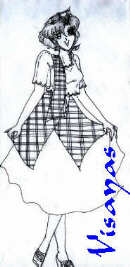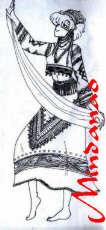
Mabuhay, and welcome to the Lake of Illusions' Centennial of Philippine Independence Special! June 12, 1998 marks the one hundredth anniversary of Philippine independence from foreign powers. Land of a proud brown-skinned race of people, the Philippines has been coveted by colonial powers for as far as history can be remembered, because of its abundant natural resources, its strategic location in Southeast Asia, and its supposedly "uncivilized" natives. For a span of about 400 years, the Filipino people have been under Hispanic, British, American and Japanese rule. Being a freedom-loving and nationalistic people, the Filipinos fought long and hard for their long-sought independence. Brave men and women have died to attain the freedom we Filipinos enjoy now, so as one nation, we now cry:
"Mabuhay ang Inang Bayang Filipinas!"
Sit back and Relax! The Lake of Illusions' Centennial Fashion Show begins…

Para sa Luzon:
Ating bigyan ng masigagong palakpakan ang unang kasuotan sa ating palabas! Si Binibining Ami Mizuno ay narito para ipakita sa ating lahat ang kasuotan ng mga Ifugao. Ang mga Ifugao ay isa lamang sa mararaming pangkat etniko ng Pilipinas, at sila'y nakatira sa Mountain Province, kung saan marami sa kanila ang naroon pa rin kahit sa kasalukuyang panahon. Sila ay sumikat sa kanilang matiyagang pag-ukit at paggawa ng tanyag na Banaue Rice Terraces, na tinaguriang pang-walong "Wonder of the World".
Ang suot ni Ami ay isang paldang gawa sa telang itim, puti at pula na karaniwang hinahabi ng mga kababaihang Ifugao, at ang kanyang palamuti sa ulo ay gawa sa mga balahibo ng ibon at mga maliliit na "beads" na gawa sa kahoy.
English Translation:
For Luzon:
Let us all give a hearty round of applause for the first outfit in our show! Miss Ami Mizuno is here to show us all the native costume of the Ifugao. The Ifugao is only one of the many ethnic groups in the Philippines, and they live in the Mountain Province of the Philippines, where many of them still live to this very day. Their claim to fame is the wondrous Banaue Rice Terraces, considered the Eighth Wonder of The World, which they have patiently carved out of a mountain.
Ami's skirt is made of a black, red and white cloth, woven in the traditional way of back strap weaving done by the Ifugao women, and her headdress is made of bird's feathers and little wooden beads.

Para sa Visayas:
At para naman sa ikalawang kasuotan, dumapo naman tayo sa Visayas. Ang suot ni Ami ay isang kimonang gawa sa pina cloth mula sa Romblon, na talagang tinadtad ng mga tanyag na pananahi ng mga bulaklak ng mga taga-Iloilo. Ang kanyang pang-ilalim na damit ay gawa sa putting seda, habang ang kanyang bandana, tapis at patadyong ay gawa naman sa dilaw at luntiang tela. Ang kanyang bakya ay matiyagang inukit mula sa kahoy, at nilagyan naman ng mga kabibeng palamuti mula sa Cebu.
English Translation:
For Visayas:
And for our second outfit, let us move over to Visayas. Ami is wearing a
kimona made of hand-woven pina cloth from Romblon, and is adorned with the intricate flower embroidery of the Iloilo folk. The dress she is wearing underneath is made of white silk, while her bandanna, tapis and patadyong are made of a plaid yellow and applegreen silk cloth. Her shoes were skillfully carved from wood and is inlaid with pretty shellcraft from Cebu.
Para Sa Mindanao:
Ang ating huling kasuotan ay galing sa Mindanao. Ang suot naman ngayon ni Ami ay galing sa mga T'boli (isa sa mga mararaming grupo etnikong buhay pa rin sa Pilipinas), na siyang sikat sa kanilang tunay na kabighabighaning T'Nalak na tela, na mula sa abaka. Ang kanyang pang-itaas at pam-baba ay gawa sa bughaw na telang T'Nalak, at ang kanyang palamuti sa ulo at makapal na sinturon ay gawa sa kwintas ng mga makukulay na "beads" at mga maliliit na bolang kumikililing tuwing kinakalog.
English Translation:
For Mindanao:
Our last featured outfit is from Mindanao. What Ami is wearing now is from the tribal group of T'Boli (one of the many Filipino ethnic groups still thriving today), famed for their truly captivating T'Nalak cloth made from abaca. Her blouse and skirt are both made from navy blue T'Nalak cloth, and her headdress is made from strings of colorful beads and delicate bronze chimes.
Dito nagtatapos ang ating maikling palabas. Maraming salamat po, at hanggang sa muli!
Mabuhay ang Pilipinas!
This ends our short fashion show. Thank you very much, and until next time!
Long live the Philippines!
All outfits on this page were designed and drawn by Bowaggi based on her research and knowledge of Filipino attire. They were scanned by the Kitchen Raiders. Permission from either party to use any of these pictures is needed before they are to be used in any other page. Arigatou!